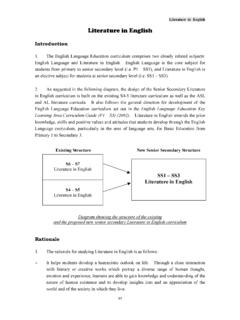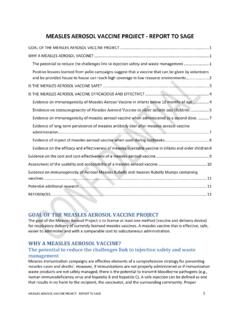Transcription of Case Report Prosthodontic Treatment of a Patient …
1 22 Volume 1, Number 1, 2012 Sheng-Wei FengSchool of Dentistry, T aipei Medical University, T aipei, TaiwanPei-Bang LiaoTaipei Medical University Hospital, Taipei, TaiwanMay-Show ChenSchool of Dentistry, T aipei Medical University, T aipei, TaiwanTaipei Medical University Hospital, Taipei, TaiwanCorresponding author:Sheng-Wei FengSchool of Dentistry, T aipei Medical University, T aipei, Taiwan250 Wu-Hsing Street, Taipei, TaiwanTel: 886-2-2736-1661 ext. 5148; Fax: 886-2-27362295 AbstractCombin ation syndrome commonly occurs in patie nts with a completely edentulous maxilla opposed by a bilateral distal -extension removable partial denture. is syndrome poses a considerable challenge to dentists. e symptoms of the s y ndrome consi st of anter ior ma x i l lar y bone loss, mandibular bone loss, tuberosity overgrowth, and alveolar rid ge cantin g.
2 All of these e ects render prosthetic Treatment more difficult, and although it is preferable to use denta l implants for functional support, complex cases still require conventional prosthetic tr eatments for medical or nancial reas h i s c l i n i c a l r e p o r t p r e s e n t s t h e p r o s t h o d o n t i c management of a Patient exhibiting combination syndrome along with a discussion of rele vant l it : Combination syndrome, distal- extension RPDI ntroduction The oral rehabilitation of patients with an edentulous maxilla opposed by natural mandibular anterior teeth is a consider able challenge for many clinicians. These cases pose many potential problems, including loss of bone from the anterior edentulous maxilla and super-eruption of unopposed mandibular anterior teeth.
3 Kelly (1972) proposed the term combination syndrome for this oral condition and its resultant clinical features. e Glossary of Prosthodontic Terms1 has defined combination syndrome as: the charact eristic fe atures that occur when an edentulous maxilla is opposed by natural mandibular anterior teeth, including loss of bone from the anterior portion of the maxillar y ridge, overgrowth of the tuberosities, papillar y hy p er p l a s i a o f t h e hard pa l at a l mu co s a , e x t r u s i o n o f mandibular anterior teeth, and loss of alveolar bone and ridge height beneat h the posterior mandibular re movable denta l prosthesis bases also called anterior hyperfunction (1972)2 obser ved 20 patients equipped w ith complete ma x illar y dentures opposing distal-extension removable par tial dentures (RPD).
4 After three years of follow-up, six of these patients showed a reduction of the anterior bony ridge height ( mm) on lateral cephalometric ra diogra phy. Meanwhile, an increasing bone level of the tuberosities ( mm) was noted in ve patients . Kelly (1972) proposed the preservation of posterior teeth to support lower partial dentures and a more stable occlusion to avoid combination syndrome. Preser vation case ReportProsthodontic Treatment of a Patient with Combination Syndrome: A Clinical case Report Journal of Prosthodontics and Implantology 23 case ReportCase ReportA 73-year-old male patie nt was referred to the Dentistry Department of Taipei Medical Universit y Hospital in Taipei, Taiwan, for restorat ive Treatment .
5 The pat ient 's chief co mpla i nt s were i nad eq u ate retent i o n o f ma x i l lar y complete denture and inab i lit y to c h ew co mf o r tabl y. No majo r s y stemi c diseases or drug allergies were reported. On examination, the Patient had an edentulous maxilla and nine natural mandibular anterior t e e t h ( Fi g u r e 1 ) . C l i n i c a l l y, t h e p a t i e n t d i s p l ay e d a n t e r i o r b o n e l o s s a n d f l a b b y tissue of the maxillar y ridge, overgrowth of the maxillary tuberosities, and over-erupted mandibular anterior teeth (Figure 2). The pat ient re jec ted any su rger y an d implant therapy due to financial considerations. The patie nt agr eed to have a new comple te denture and a mandibular removable partial denture o f p o s te r i o r o c c l u s i o n a n d av o i d a n c e o f anterior hy perf unction are considered the p r i ma r y t r e a t me n t s u g g e s t i o n s f o r t h i s complex condition.
6 Saunder et al (1979)3 and Jameson (2001)4 suggested the use of an alternative tooth form and occlusal concept ( linear occlusion) and minimum anter ior contact for reducing further bone loss caused by hyperfunction of anterior teeth. Previous studies advocated osseointegrated implant-retained or implant-supported prostheses to change the occlusal force distribution and decrease the traumatic stress to the alveolar bone resultin g from combin ation e p r e s e n t r e p o r t d e t a i l s t h e p ro s t h o d o n t i c ma nage me n t o f a s p ec i f i c Patient exhibiting symptoms of combination 1. Panoramic radiograph showing a typical case of combination syndrome with severe resorption of the anterior maxillary and super-eruption of unopposed mandibular anterior 2.
7 : (a) Occlusal view of maxillary arch. (b) Occlusal view of mandibular a r c h s h o w i n g t o o t h c r o w d i n g . ( c ) Right-side view revealing the retained canine. (d) Preoperative frontal view showing greater bone resorption of the premaxillary area. (e) Left-side view indicating sufficient restoration space.(a) (d) (b)(e)(c)24 Volume 1, Number 1, 2012 case Reportsemi-adjustable articulator (Whip Mix 3040, L o u i s v i l le, Kent u c ky, US A ) . In ad d it io n , an intraoral Gothic Arch Tracer (Simplex , Dentsply, New York , USA) was applied to ver if y accurate and reproducible occlusal vertical dimension (OVD) and centr ic relation (CR)(Figure 3c). e selection of maxillary anterior arti cial teeth was determined by Patient gender and personality.
8 Balanced occlusion was indicated for this case to assure an even distribution o f o c c l u s a l f o r c e a n d p r e v e n t o c c l u s a l interferences on the residual ridge. The tooth arrangement was checked for esthetic s and CR position and then submitted for processing. After prescrip, both casts were remounted, ad j u s te d , a n d p o l i s h e d . A t a s u b s e q u e n t appointment, the finished prostheses were delivered and minimal occlusal adjustment was needed. e patie nt was ple as ed with their appearance and chewing abili ty. A maintenance program includi ng oral hygiene instruction and prosthesis home care was established. At the 18-month maintenance visit, no complications were of patients with an edentulous ma x i l l a o p p o s e d t o n a t u r a l ma n d i b u l a r anterior teeth and a distal-extension RPD is considered a chal lenge for dental pract it ioners.
9 Combination syndrome has a prevalence ra te a er some i t i a l t h e ra p y i n c l u d ed o ra l hy g i e n e instructions, caries control, and nonsurgical p e r i o d o n t a l t h e ra p y. A t t h e f i r s t c l i n i c a l appointment for Prosthodontic Treatment , a preliminar y impression of the ma x i l lar y a n d ma n d i b u l a r a r c h e s w a s ma d e w i t h irreversible hydrocolloid materials (Hydrogum, Zhermack , Badia Polesine, Italy) and poured with dental stone. A custom tray was fabricated for the maxillary complete denture impression and a wax relief was applied to the anterior abby ti ssue area. A green modeling compound (GC Corp, Tokyo, Japan) was then used to obtain accurate denture border position and seal.
10 E de nitive impression of the maxillary a r c h w a s ma d e w i t h v i n y l p o l y s i l o x a n e impression material (Virtual , Ivoclar Vivadent, Schaan, I taly) ( F igure 3 a). A d e niti ve c ast was created with type III dental Kennedy Clas s I RPD of the mandibular arch was designed after sur vey ing the cast. Following tooth preparation, the definitive impression of the RPD framework was made w ith v inyl polysilox ane material (Aquasil, Dentsply Caulk , Milford, Delaware, USA). The altered-cast technique was promulgated to improve the stability of the mandibular RPD and correct any errors incurred at the f irst impression stage. A f ter the face-bow transfer , the maxillary and mandibular mast er casts were mounted in centric relation on a (a) (a) (b)(b)(c)(c)Figure 3.





